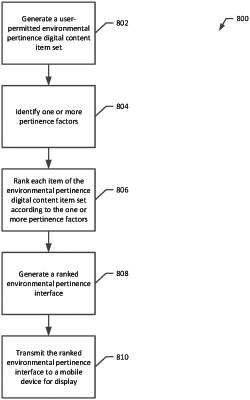| CPC G06F 3/048 (2013.01) [G06F 16/435 (2019.01); H04W 4/025 (2013.01); G06F 2219/10 (2013.01)] | 20 Claims |

|
8. A method of identifying digital content items using an environmental pertinence server, the method comprising:
receiving a request for an interface item from a first mobile device operating a first client application operably coupled to at least one application server or a second mobile device operating a second client application operably coupled to the at least one application server;
receiving a first location data associated with the first mobile device and a second location data associated with the second mobile device;
in accordance with the second location data satisfying a proximity criteria with respect to the first location data, identifying a first digital content item displayed using the first client application and a second digital content item displayed using the second client application;
obtaining a first user profile associated with the first client application on the first mobile device and a second user profile associated with the second client application on the second mobile device;
in accordance with the first user profile having permissions to access the second digital content item, causing the first client application to display a first interface item corresponding to the second digital content item; and
in accordance with the second user profile having permissions to access the first digital content item, causing the second client application to display a second interface corresponding to the first digital content item.
|